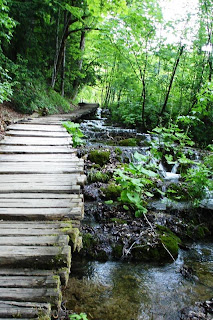
 In central Croatia lies the UNESCO World-heritage listed travel wonder of Plitvice Lakes. This necklace of 16 lakes, in an artist’s palette of colors from emerald green, through azures and turquoises to deep sapphire blue, are separated by walls of algae, moss, roots and stone. The water flows between the lakes in a series of tumbling waterfalls and gushing streams, constantly refreshing and filling the neighboring lake.
In central Croatia lies the UNESCO World-heritage listed travel wonder of Plitvice Lakes. This necklace of 16 lakes, in an artist’s palette of colors from emerald green, through azures and turquoises to deep sapphire blue, are separated by walls of algae, moss, roots and stone. The water flows between the lakes in a series of tumbling waterfalls and gushing streams, constantly refreshing and filling the neighboring lake. The geological story is remarkable and fascinating. The water in the lakes is rich in calcium carbonate leeched from the dolomite and limestone valleys in the area.
The geological story is remarkable and fascinating. The water in the lakes is rich in calcium carbonate leeched from the dolomite and limestone valleys in the area. This mineral enriches the water giving the lakes their vivid shades of blue and green. Calcium carbonate has an unusual chemical property which means it releases from water only when the water is running, tangling and embedding itself in the plants and mosses between the lakes, hardening and turning itself into a porous rock called travertine. These hardened stone walls effectively act as barriers between the lakes acting like dam walls.
This mineral enriches the water giving the lakes their vivid shades of blue and green. Calcium carbonate has an unusual chemical property which means it releases from water only when the water is running, tangling and embedding itself in the plants and mosses between the lakes, hardening and turning itself into a porous rock called travertine. These hardened stone walls effectively act as barriers between the lakes acting like dam walls.
Much as limestone caves slowly evolve over the centuries and millennia, Plitvice Lakes continue to change as the travertine walls, plant life and water form and erode, continually and subtly changing the landscape of this majestic area. Surrounding the lakes are rich forests of beech, firs and pine trees, creating elegant patterns and reflections in the crystal waters.Wooden boardwalks and natural paths surround many of the lakes. Electric buses ferry visitors to the far end of the lakes and an electric boat plies the waters of the largest lake which connects the so-called Upper Lakes with the four Lower Lakes. Strolling around and between these lakes on the undulating paths is comfortable and relaxing, the walk being spiced with the soothing sounds of running streams and the twittering of birds and the vision of colorful flowers and thousands of small fish.
Surrounding the lakes are rich forests of beech, firs and pine trees, creating elegant patterns and reflections in the crystal waters.Wooden boardwalks and natural paths surround many of the lakes. Electric buses ferry visitors to the far end of the lakes and an electric boat plies the waters of the largest lake which connects the so-called Upper Lakes with the four Lower Lakes. Strolling around and between these lakes on the undulating paths is comfortable and relaxing, the walk being spiced with the soothing sounds of running streams and the twittering of birds and the vision of colorful flowers and thousands of small fish. One useful tip suggested to me by the helpful national park staff was to walk up-hill so that the best views of this enticing water garden always lay in front of you. The vast majority of people take the easier downhill approach.
One useful tip suggested to me by the helpful national park staff was to walk up-hill so that the best views of this enticing water garden always lay in front of you. The vast majority of people take the easier downhill approach.
Near the lower lakes and a favorite vantage point for group photographs is Croatia’s largest waterfall at around 80 metres (90 yards), though other waterfalls were more striking for their setting. Ironically this largest waterfall is fed from an external river and not from the runoff of another lake.
Plitvice Lakes make for a wonderful day-long escape to nature. Watch in awe at one of nature’s great travel wonders as water magically turns to stone.
Travel Guides for destinations worldwide. Our Travel Guides are the most comprehensive travel guides on the web written by professional travel experts over.
Sabtu, 30 Oktober 2004
The Aquamarine Necklace (Plitvice Lakes, Croatia)
Langganan:
Posting Komentar (Atom)
Tidak ada komentar:
Posting Komentar